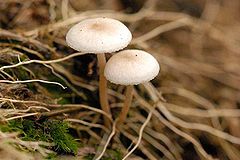- Collybia
-
Collybia 
Collybia cookei Scientific classification Kingdom: Fungi Phylum: Basidiomycota Class: Basidiomycetes Order: Agaricales Family: Tricholomataceae Genus: Collybia
(Fr.) StaudeType species Collybia tuberosa
Fr.Species Collybia (in the strict sense) is a genus of mushrooms in the Tricholomataceae family.[1] The genus has a widespread but rare[2] distribution in north temperate areas, and contains three species that grow on the decomposing remains of other mushrooms.[3]
Until recently a large number of other white-spored species, some very common, were assigned to this genus, but now the majority have been separated into other genera: Gymnopus, Rhodocollybia and Dendrocollybia.
Contents
Collybia sensu lato
Collybia sensu lato is one of the groups of fungi of the Agaricales order that has created taxonomic differences of opinion in the scientific community.[4] The generic name Collybia is due to Elias Magnus Fries and first appeared in 1821. Collybia was a originally a tribe from an Agaricus classification. In 1857, Friedrich Staude recognized Collybia as a genus. The name Collybia means "small coin".[5] Later in his systematic work of 1838,[6] Fries characterized Collybia as those species with
- white spores,
- incurved cap margin,
- central cartilaginous stipe, and
- fruit bodies which decay easily ("putrescent").
The last criterion divided these mushrooms from those of Marasmius, which had the property of being able to revive after having dried out (called "marcescent"). Although Fries considered this an important characteristic, some later authors like Charles Horton Peck (1897)[7] and Calvin Henry Kauffman (1918)[8] did not agree with Fries's criteria for the classification, and Gilliam (1976) discarded marcescence as a characteristic for the identification and differentiation of these genera.[9]
At that point the very varied genus encompassed the modern genera Oudemansiella (including Xerula), Crinipellis, Flammulina, Calocybe, Lyophyllum, Tephrocybe, Strobilurus, and others.
In 1993, Antonín and Noordeloos published the first part of a monograph of the genera Marasmius and Collybia after conducting a survey of these genera in Europe.[10] In 1997, they published the second part of the monograph that included all Collybia species. In 1997, Antonín and colleagues published a generic concept within these two genera and organized the nomenclature to provide a new combination of genera: Gymnopus, Collybia, Dendrocollybia, Rhodocollybia and Marasmiellus.[4] The nomenclature and reclassification has since been supported by subsequent molecular analysis.[11][12] Most of these mushrooms belong to the Marasmiaceae family and have low convex caps and white gills, with adnate attachment to the stem. This general form has given rise to the term collybioid, which is still in use to describe this type of fruit body.
Collybia sensu stricto
The type species for Collybia is C. tuberosa, a small white parasitic mushroom (with caps up to 1.5 cm (0.6 in)) which develops from a black sclerotium on putrescent fungi (or other decaying vegetation).[13][14]
The three species remaining in the genus are small (up to 2 cm (0.8 in)). The caps are whitish and often radially wrinkled.[2] All three species are saprobic, and grow on the decomposing remains of other mushrooms.[14] When the genus was split up, the much-reduced genus was moved from Marasmiaceae to Tricholomataceae.
See also
- List of Tricholomataceae genera
- List of Marasmiaceae genera
References
- ^ Staude F. (1857) (in German). Die Schwämme Mitteldeutschlands, in besondere des Herzogthums. p. 119.
- ^ a b Knudsen H, Vesterhout J, ed (2008). Funga Nordica. Copenhagen, Denmark: Nordsvamp. p. 403. ISBN 9788798396130.
- ^ Kirk PM, Cannon PF, Minter DW, Stalpers JA. (2008). Dictionary of the Fungi (10th ed.). Wallingford: CABI. p. 160. ISBN 9780851998268.
- ^ a b Antonín V, Halling RE, Noordeloos ME. (1997). "Generic concepts within the groups Marasmius and Collybia sensu lato". Mycotaxon 63: 359–68. http://www.cybertruffle.org.uk/cyberliber/59575/0063/0359.htm.
- ^ Smith AH, Weber NS. (1980). The Mushroom Hunter's Field Guide. Ann Arbor, Michigan: University of Michigan Press. p. 137. ISBN 0-472-85610-3. http://books.google.com/books?id=TYI4f6fqrfkC&lpg=PA137&dq=collybioid&pg=PA137.
- ^ Fries EM. (1838). Epicrisis systematis mycologici. Uppsala, Sweden: Typographia Academica.
- ^ Peck CH. (1897). "Report of the state botanist". Annual Report of the New York State Museum 49: 18–83.
- ^ Kauffman CH. (1918). The Agaricaceae of Michigan. Lansing: Wynkoop, Hallenbeck Crawford Co..
- ^ Gilliam MS. (1976). "The genus Marasmius in the northeastern United States and adjacent Canada". Mycotaxon 4: 1–144. http://www.cybertruffle.org.uk/cyberliber/59575/0004/001/0001.htm.
- ^ Antonín V, Noordeloos ME. (1993). A Monograph of Marasmius, Collybia and Related Genera in Europe, Part 1: Marasmius, Setulipes and Marasmiellus. Libri Botanici 8. IHW Verlag. ISBN 3980308359.
- ^ Hughes KW, Petersen RH, Johnson JE, Moncalvo J-E, Vilgalys R, Redhead SA, Thomas T, McGhee LL. (2001). "Infragenic phylogeny of Collybia s. str. based on sequences of ribosomal ITS and LSU regions". Mycological Research 105 (2): 164–72. doi:10.1017/S0953756200003415.
- ^ Moncalvo JM, Vilgalys R, Redhead SA, et al. (2002). "One hundred and seventeen clades of euagarics". Molecular Phylogenetics and Evolution 23 (3): 357–400. doi:10.1016/S1055-7903(02)00027-1. PMID 12099793. http://linkinghub.elsevier.com/retrieve/pii/S1055-7903(02)00027-1.
- ^ Volk T. "Collybia tuberosa, the mushroom-loving Collybia". Tom Volk's Fungus of the Month for June 2004. http://botit.botany.wisc.edu/toms_fungi/jun2004.html. Retrieved 2010-12-19.
- ^ a b Halling RE (14 July 2009). "Collybia sensu stricto". A revision of Collybia s.l. in the northeastern United States & adjacent Canada. http://www.nybg.org/bsci/res/col/collsp.html#cirrhata. Retrieved 2010-12-21.
External links
Categories:
Wikimedia Foundation. 2010.

